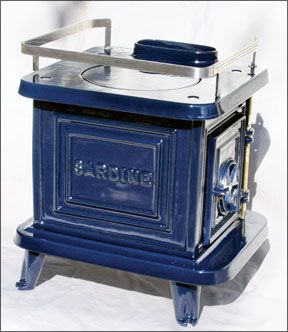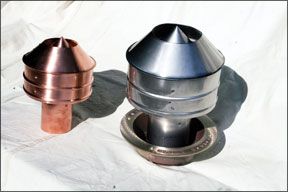Tucked into a wooded hillside in the San Juan Islands of Washington state, Navigator Stove Works is a young family operation attached to a long history of vintage stoves. Formally of Brooklyn, N.Y., and now based on Orcas Island, Navigator produces three compact wood-burning, cast-iron stove models for use on land and at sea. Originally designed for use aboard boats, the scaled-down stoves are also popular for cabins, RVs, and other small structures on terra firma.
Two of the Navigator stove patterns-the Sardine and the Little Cod-originally were made in the Lunenburg Foundry in Nova Scotia, Canada. The company, founded in 1891, manufactured a wide range of marine equipment for commercial vessels and yachts. Lunenburg ceased producing stoves in the early 1990s with the closure of its iron foundry operations. Navigator produces the Sardine and Little Cod using Lunenburgs foundry patterns.
The third model, the Halibut, is designed by Navigator and is based on old East Coast favorite, the Shipmate No. 212. Navigator also has a fourth stove in the works: a biodiesel prototype, the Herring. The Navigator stoves are custom made by order only, and the company is currently producing about 75 a year.

Safety First
As with any stove or heat source aboard, users must follow manufacturers installation instructions explicitly and heed their warnings to ensure safe operation. Installed in accordance with the manual, all Navigator stoves meet American Boat and Yacht Council liquid and solid fuel boat heating systems standards. These and other applicable U.S. and Canadian fire standards are also outlined in the manual, which all prospective buyers should study closely. For safety reasons, the stoves should not be used on a gasoline-powered boat.
The iron stoves are cast in the northeastern United States and then shipped in sections to Andrew Moore at Navigator Stoves on Orcas Islands. The stoves are sold as plain iron with a traditional stove polish, but a customer can opt to add one of six porcelain enamels -grey, black, mint, deep mariner blue, dark green, or classic barn red.
Moore prepares, polishes, and smooths the iron on each stove at his workshop, and then tweaks and assembles those ordered as polished iron. Stoves that are ordered with the porcelain coating are sent to the Midwest for coating, then flat-packed back to Moore for polishing, tweaking, and assembly. Lead times vary from one week to eight weeks, depending on availability.
All three stoves are designed to burn natural wood and charcoal. The two smallest models are best for heating 300 square feet or less. The largest model, the Halibut, is able to burn coal. The stoves are not intended for use with any other fuel sources. For use in warmer months, Navigator has designed alcohol drop-in burners. The drop-in burner literally drops into the stove top and burns denatured alcohol. The burner element is self-pressurizing and is located in the cast-bronze burner housing to minimize fuel spills. One 2-ounce filling will burn for 20 minutes. Running in simmer mode, the burn time is doubled. Tests show it takes 8 minutes to boil a liter of water. The alcohol can be refilled for longer cook times.

Navigator Stoves also sells many of the accessories associated with installing and maintaining a wood burning stove, including stove pipes, deck heads, and heat shielding. Heat shielding can be a critical issue, and Navigator offers custom-made shielding panels made from either 20-gauge stainless steel or 16-ounce copper.
Sardine
The smallest and most popular model, the Sardine is a mere 12 by 12 by 11 inches, and weighs 35 pounds. The heat output is 7,500 to 18,000 BTUs.
Navigator Stoves suggests using this rule of thumb for determining required BTU: 15 x volume of space to heat = required BTUs. If extreme cold temperatures are expected, one might want to use a factor of 20. This compact Sardine is best suited for small boats or sleeping cabins aboard larger vessels. It is two-thirds the size of the Little Cod and costs $699 for plain iron and $1,199 for the porcelain enamel option.
Little Cod
First produced circa 1917, this solid-fuel stove was initially designed to keep fishermen warm and well fed as they jigged for cod. Simple and reliable, it is economical to run and maintain. It is intended for use in the galley, cabin, or pilothouse, or small spaces on land. By adding one or two of the alcohol drop-ins, it can essentially replace any alcohol stove onboard. The Little Cod measures approximately 13 by 18 by 14 inches and weighs 55 pounds. It produces 10,000 to 28,000 BTUs. It has a stainless-steel sea rail to keep cook pots in place, and has holes in the legs for securing stove to a platform. It is priced at $1,125 for iron and $1,675 with porcelain or $1,875 for red porcelain.
Halibut
The Halibut has cast-bronze sea rails and corner posts. It has a glass firebox door, stainless-steel ash pan and oven rack, an oven thermometer, and a Halibut relief on the door. The Halibut doesn’t come up to temperatures as fast as the little stoves, but it does offer the oven for onboard cooking of bread, potatoes, and pies. It can also burn coal, whereas the smaller stoves are designed for wood and charcoal only. The platform size for the Halibut is 26 inches wide minimum, and 18 inches deep. The oven is 9 by 9 by 8 inches, and the stove weighs 175 pounds. The approximate heat output is 25,000 to 35,000 BTUs. The stove costs $2,850 with porcelain.

Herring Prototype
Navigator Stoves is also currently working on a diesel/ biodiesel prototype stove. It is intended to be 28 inches tall with a 12-by-12-inch footprint, and weigh 55 pounds. The Herring will have a glass-plate front and a herring relief on the front plate. It is designed with a “blue flame” natural draft burner from Europe and no fan or electricity is required. Tests by Navigator have shown a very clean, steady burn. The expected BTU rating is 16,000. Navigator is also working on a design for a water heating loop.
Conclusion
The Navigator stoves are functional art, a nostalgic throwback to simpler times. If convenience is your top priority, then don’t bother. Like any wood-burning stove, these come with soot, ash, and smoke, all of which can find its way onto the deck and cabintop. The cast iron construction is rugged, but it is also heavier than other heating options. Wood stoves take longer to heat up then a gas oven, and they require supervision and maintenance. But, notes Moore, that is the point, really.
A woodburning stove involves the sort of philosophical shift that a wooden boat requires: Convenience and ease of maintenance are not the aims. If you subscribe to the idea of a lifestyle of the present, in which you tend your fire, not just switch it on, then these well built, finely finished stoves fit the bill.
The stoves can be installed by an experienced and involved do-it-yourselfer in a couple of weekends, with the lions share of the time dedicated to thinking and planning, rather than installing.






































Have a Tiny-Tot wood and coal burner on my Mason. Custom tools for tending. Makes it easy to keep clean. Fire it up early. Easier to maintain the daytime heat than to start from scratch. Reload later in the eve, good all night. Wake up to a warm boat.